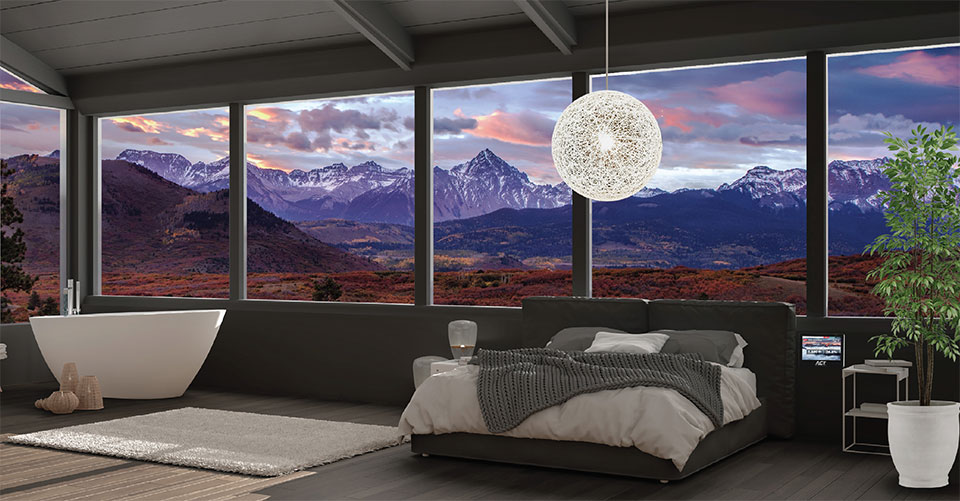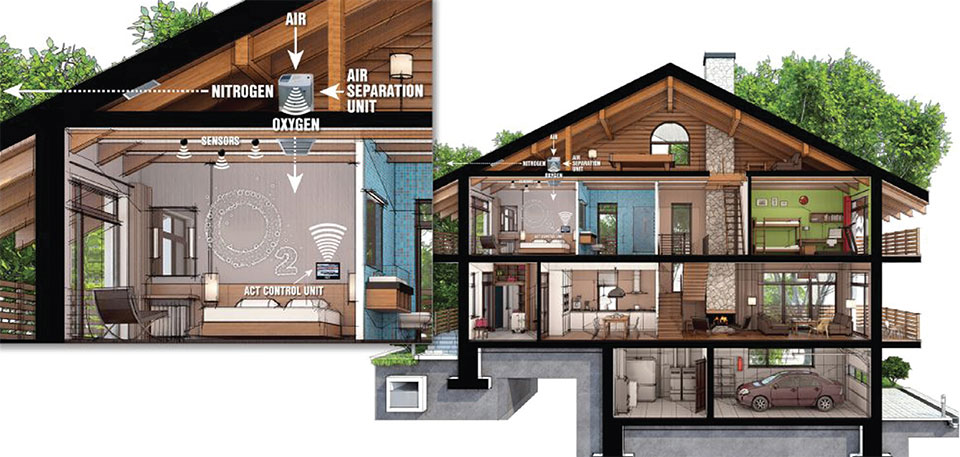The Fix for When You Can’t Dream in Your Dream Home
Moderated & Edited by Cassidy Mantor
Larry Kutt, CEO of Altitude Control Technologies, is a mountaineer and former mountain rescue volunteer. Kutt says that his climbing experience first exposed him to how different it feels at 14,000 feet compared to lower elevations. As a member of Rocky Mountain Rescue, Kutt was trained on how to diagnose and treat patients with altitude sickness.
Headaches, problems sleeping, poor physical and mental performance, and recovery issues are the most common altitude maladies. The solution was always the same: Go down the mountain. Symptoms would resolve quickly with decreasing altitude.
“Sleep quality is usually the first thing people notice in cases of altitude sickness. They’re not sleeping so they’re not well-rested. They wake up and don’t feel well, which is not how anyone wants to wake up in their dream home.”
–Mr. Larry Kutt, CEO, Altitude Control Technologies

When someone is in their mountain home and not feeling well, the last thing they want to do is leave their home and drive to a lower altitude. Altitude Control Technologies (ACT) solves the issue of hypoxia, or low oxygen, by simulating a comfortable altitude so homeowners can thrive at high altitude.
ACT began by creating environments to help elite athletes improve their performance. ACT’s technology is so accurate that it has been used by professional sports teams, Olympic training facilities in 14 countries, the U.S. Ski Team, the military, and medical experts at the top research facilities, including the Mayo Clinic and Harvard Medical School.
ACT’s mountain home application launched when a homeowner requested help for his wife, who was having headaches and not sleeping in their mountain-top dream home. ACT’s team of engineers developed the system to increase oxygen levels and simulate lower elevations to prevent mountain sickness. This personal health application particularly resonated with Kutt after his mountain rescue experience.
Western Home Journal sat down with ACT’s CEO Larry Kutt and board-certified physician Dr. Peter Hackett, who is a Clinical Professor at the Altitude Research Center, in the Division of Pulmonary Sciences and Critical Care Medicine, University of Colorado—Anschutz Medical Campus. Read on to learn how valuable oxygenated rooms are in mountain homes.
whj : What is altitude sickness?
Mr. Larry Kutt: Sleep quality is usually the first thing people notice in cases of altitude sickness. They’re not sleeping so they’re not well-rested. They wake up and don’t feel well, which is not how anyone wants to wake up in their dream home. Headaches are a big part of it too.
Dr. Peter Hackett: Everyone understands the importance of oxygen. At 9,000 feet you’re getting 30 percent less oxygen than at sea level. That’s a significant enough loss to create issues.
whj : How does ACT fix that?
Dr. Hackett: Our team includes medical doctors like me, PhDs in physiology and leaders in altitude-related research. We based our system on studies that measured sleep physiology during oxygen-enriched sleep patterns at high altitudes. These studies showed improved sleep patterns and quality of sleep, and improved mood and performance the next day, as well as protection from mountain sickness after a night in an oxygenated room. As a team, we collaboratively make sure our data and processes are real, that our product is safe, and that it’s effective.

Mr. Kutt: Our first order of business is to “do no harm” and make sure people are getting sufficient oxygen to eliminate altitude sickness and related insomnia.
whj : HOW DOES THE ACT SYSTEM WORK?
Mr. Kutt: We have a three-part system that involves air separation, sensors, and a control system. Air separation technology extracts oxygen from the air and delivers it to the bedroom in a constant flow. The system measures barometric pressure. It then adjusts oxygen every six seconds to meet the National Fire Prevention Association guidelines. It also meets the Center for Disease Control’s standard for safe oxygen levels.
Dr. Hackett: The oxygen system in the house uses molecular sieves. They take in ordinary air, push it through the sieves and filter out nitrogen, concentrate the oxygen, and put it in the bedroom.
Mr. Kutt: This restores oxygen to approximate sea level so you can sleep and feel better. We install the main component in an attic, crawl space, or garage. It’s completely quiet in the bedroom.
Dr. Hackett: We put a barometric pressure sensor in the bedroom, two oxygen sensors, and a carbon dioxide sensor to measure indoor air quality. The sensors calibrate themselves, so you don’t have to. They continuously monitor the air in the room and send that data to the control module. The control module is the brains of the whole system. It also actively manages oxygenation to make sure it stays within fire safety guidelines at all times.
Mr. Kutt: The control panel displays altitude simulation and the percentage of oxygen. This display connects to the internet for monitoring and diagnostics. You can control your oxygenation system remotely from your smartphone from anywhere in the world. The system can also communicate with high-tech home automation systems such as Savant or Crestron. It’s also the only oxygenation system that meets OSHA’s standard for indoor air quality.

“The oxygen system in the house uses molecular sieves. They take in ordinary air, push it through the sieves and filter out nitrogen, concentrate the oxygen, and put it in the bedroom.”
–Dr. Peter Hackett, Clinical Professor, Altitude Research Center
whj : Does the system have to run all the time to be effective?
Mr. Kutt: No, it doesn’t need to run all the time. The system is programmed to oxygenate rooms when needed.
whj : How hard is it to add ACT’s oxygenation system to a mountain home?
Mr. Kutt: Installation is very straightforward and usually takes one or two days. Oxygenation is becoming the gold standard for luxury mountain homes. Our average order is for the master bedroom and one to two guest rooms. I think it’s important to people who are buying beautiful homes that they can enjoy them. They know they’ll feel better.
Dr. Hackett: People wonder what happens when they leave the room. All you need is to disrupt the cycle of hypoxia for a few hours to feel better. Sleeping in an oxygenated room for eight or nine hours makes all the difference.
whj : What’s your favorite part about your work?
Mr. Kutt: We are proud that we are a sole supplier to the U.S. government for altitude simulation. They funded our research and development and now use our system for research and military training. The result is now the global gold standard for oxygen control. We provide that same world-class technology to all our mountain customers. We’re solving a real problem that people have in their mountain homes, and we’re proud of that. Oxygen is a health issue. Because of our technology, people are healthier and sleep better.
